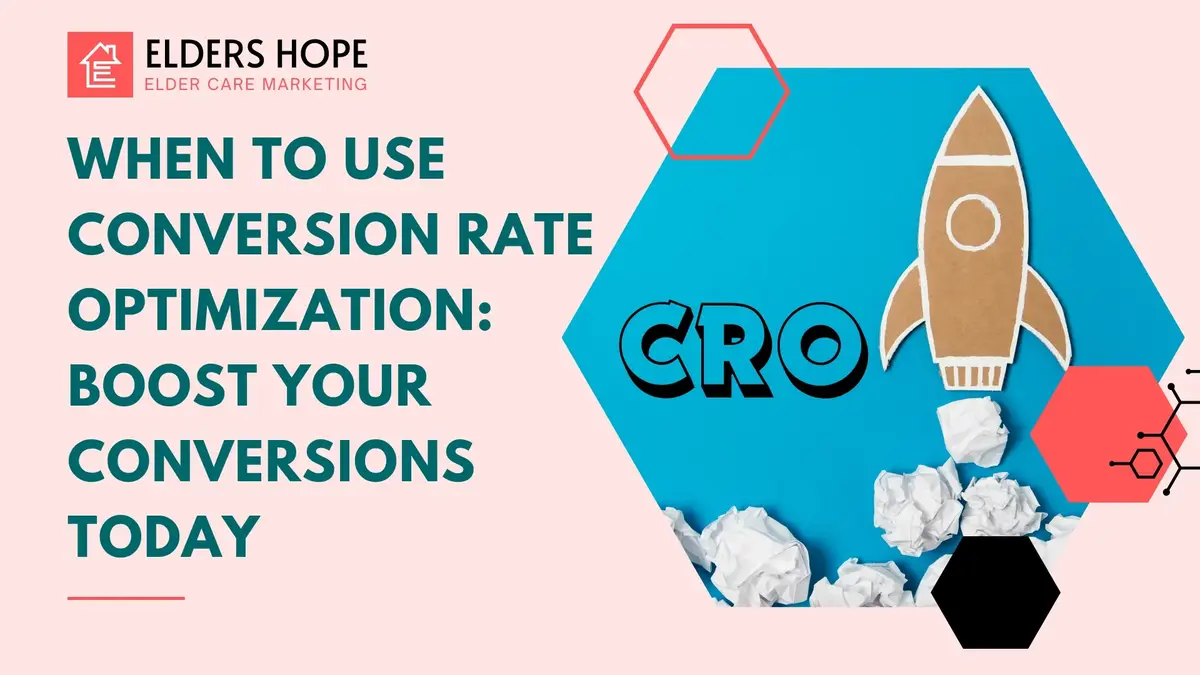Get your healthcare website



If you’re running an online business, you’re probably familiar with the term “Conversion Rate Optimization” (CRO). But when should you actually use it? Is it something to implement right from the start, or Should you wait until your business reaches a certain level of success? Let’s dive into the world of CRO and explore when it’s the right time to harness its power.
First things first, let’s break down what CRO is all about. In simple terms, CRO is the process of improving your website or landing page to increase the percentage of visitors who take a desired action, whether that’s making a buy, signing up for a newsletter, or filling out a contact form.
It’s all about maximizing the effectiveness of your online presence to drive more conversions.
Now, the pressing question arises, When should CRO be used? The answer is here, as different factors specific to each business’s online setup. Still, there are certain situations where it’s smart to use CRO strategies.
Conversion rate optimization is not just about increasing the number of conversions; it’s about improving the quality of those conversions and delivering a better overall user experience.
If you’re just starting out with your online venture, you might be wondering if CRO is worth your time and resources.
The answer? It depends. In the early stages, your focus should primarily be on building your agency as a brand, attracting traffic, and establishing a solid foundation. However, that doesn’t mean you should ignore CRO altogether.
While it might not be your top priority, implementing basic CRO strategies early on can set you up for success down the road.
Simple tweaks like optimizing your call-to-action buttons, streamlining the checkout process, and improving website navigation can have a significant impact on your conversion rates, even with a relatively small amount of traffic.
When introducing a service, it’s essential to optimize your website or landing page to maximize conversions.
CRO becomes increasingly important. At this stage, CRO can help ensure that your messaging is clear, your value proposition is compelling, and the user experience is seamless, thereby increasing the likelihood of conversions from your target audience.
Conversion Rate Optimization (CRO) principles right from the beginning can bring fantastic outcomes.
By carefully designing user experiences, adjusting call-to-action (CTA) elements, and improving navigation, businesses can establish a strong base for achieving more conversions.
In the ever-evolving realm of digital marketing, stagnation is the adversary of progress. If your website’s conversion rates have stalled or experienced a decline, it’s a clear indicator that CRO intervention is necessary.
Through comprehensive analytics assessments, A/B testing, and iterative optimizations, businesses can breathe new life into their conversion pipelines.
The digital panorama is continuously evolving, with new developments, technologies, and patron behaviors shaping the manner corporations engage with their audiences.
To stay ahead of the curve, businesses must be agile and adaptive, continuously refining their CRO strategies to align with shifting market dynamics.
With the increased with the widespread use of smartphones and tablets, mobile optimization has become increasingly important for businesses seeking to enhance their conversion rates.
Ensuring that websites are mobile-friendly and offer a seamless user experience across all devices is essential for maximizing conversions in today’s mobile-centric world.
Having a high volume of traffic is great, but if those visitors aren’t converting into customers or leads, it’s essentially wasted potential.
CRO can help optimize your website to better align with the needs and preferences of your target audience, leading to higher conversion rates despite the same traffic volume.
it’s redesigning engaging buttons, streamlining the checkout process, or improving website navigation, optimizing for conversions can help turn visitors into clients.
In today’s fast-paced digital ecosystem, consumer preferences and behaviors are subject to rapid change. To remain competitive, businesses must adapt and evolve alongside their target audience.
CRO empowers organizations to stay ahead of the curve by fine-tuning their digital assets in alignment with shifting consumer trends. By staying balanced to user preferences, businesses can sustain relevance and foster long-term growth.
By using data analytics and user behavior tracking tools, businesses gain invaluable insights into customer preferences, pain points, and conversion barriers, empowering informed decision-making.
Inconsistent sales performance could imply conversion optimization problems. By analyzing data and clients behavior, businesses can discover areas for improvement and enforce centered CRO techniques.
It’s important to optimize your website all through peak seasons like Black Friday or vacations to maximize advertising effect. If sale decline through the years, it’s a sign of needed optimization.
Adapting digital advertising techniques to evolving client behavior is important. CRO methods can revive conversion funnels and opposite downward developments.
In today’s data-driven world, businesses have a wealth of information at their fingertips that can help improve their Conversion Rate Optimization (CRO) efforts.
By using analytics tools like Google Analytics, they can understand user behavior, find conversion bottlenecks, and spot areas for enhancement.
By examining user behavior, traffic patterns, and engagement metrics, businesses can uncover valuable insights to guide decision-making and optimization strategies.
Identifying patterns and trends helps pinpoint areas for improvement. Additionally, conducting a competitive analysis can highlight opportunities for enhancing your conversion funnel.
If competitors are outperforming in conversion rates, it’s essential to study their strategies and apply similar tactics to your own website.
Analyzing your competitors’ strategies can help pinpoint areas for improvement in your own conversion funnel. If they’re achieving higher conversion rates, it’s crucial to understand what they’re doing right and implement similar tactics on your website.
Experimenting with different elements like headlines, images, and prompting action buttons can uncover the most effective combinations for driving conversions.
Through methods like A/B testing, multivariate testing, and gathering user feedback, businesses can validate hypotheses and refine their strategies for optimal results.
A/B testing, also called split testing, involves comparing two versions of a webpage to see which performs better in terms of conversion rate.
By systematically testing variations in elements such as headlines, call-to-action buttons, and page layouts, businesses can fine-tune their approach and boost conversion rates.
Conversion Rate Optimization (CRO) is crucial across business stages, from identifying needs to adapting to market shifts. It’s essential for early-stage ventures, website launches, and combating stagnant conversion rates.
By responding to market trends and consumer behavior, CRO boosts sales performance. Utilizing data-driven insights and A/B testing is key, especially for high-traffic, low-conversion scenarios. Ultimately, CRO ensures businesses maximize growth potential in dynamic market environments.
Start optimizing your conversion rates today and unlock new opportunities for success! Important links are bellow.
How Can Conversion Rate Optimization Help Your Business?
Why Is Conversion Rate Optimization Important for Homecare Business?
Popular CRO tools include Google Analytics, Google Optimize , VWO.
The timeline for seeing significant results from CRO efforts varies depending on factors such as website traffic, the extent of changes implemented, and the effectiveness of testing strategies. Generally, businesses may start noticing improvements within a few weeks to a few months.
Absolutely. Regardless of size, businesses can benefit from CRO by improving their website’s performance, increasing conversions, and maximizing their return on investment.
Get a free consultation on website design and marketing.